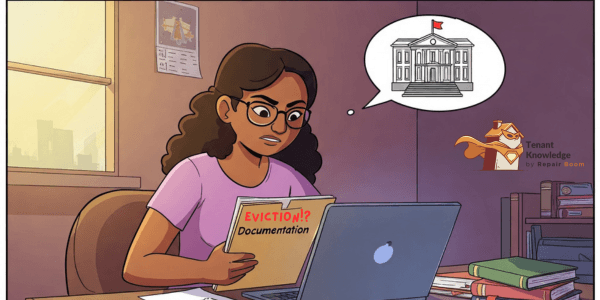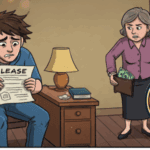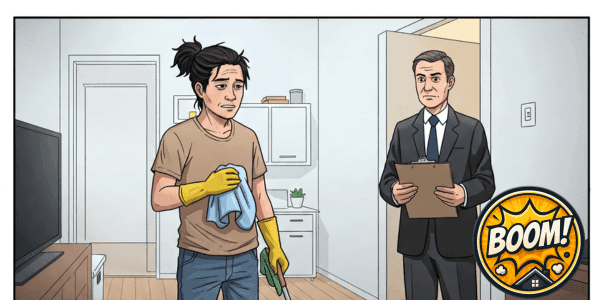
Eviction Process CA 2025
- Introduction – Understanding the Eviction Process in California
- Before You Begin: Key Considerations When Facing Eviction
- The California Eviction Process: A Step-by-Step Guide
- Spotlight on Santa Barbara Tenant Protections (2025)
- Finding Eviction Help in Your State (Nationwide Guidance)
- FAQ: California Eviction Process CA 2025
Introduction – Understanding the Eviction Process in California
Receiving an eviction notice can be one of the most stressful experiences a tenant can face. It triggers immediate anxiety about losing your home, financial stability, and future housing prospects. In California, the eviction process is strictly regulated by law, providing specific rights and procedures that both landlords and tenants must follow. Simply receiving a notice doesn’t automatically mean you have to move out immediately; it’s the start of a legal process.
At Tenant Knowledge, we understand the weight of this situation. Landlords have property rights, but tenants have rights to fair treatment and stable housing under the law. This guide is designed to help California tenants, including those in specific areas like Santa Barbara, understand the 2025 eviction process, know their rights, and navigate their options responsibly. We’ll break down the essential steps, from receiving the initial notice to potential court proceedings, and point you to resources for help, including guidance for tenants nationwide. Remember, knowledge is power, especially when facing eviction.
Disclaimer: This guide provides general information about the California eviction process as of 2025. It is not legal advice. Laws change, and local rules vary. Consult with a qualified attorney or legal aid organization for advice specific to your situation.
Before You Begin: Key Considerations When Facing Eviction
Understanding the basics can help you approach the situation more effectively:
- Landlord’s Perspective: Landlords typically initiate eviction for specific reasons outlined in the lease or by law, such as unpaid rent, lease violations, or wanting the property back for specific purposes (like owner move-in). They must follow a strict legal process; they cannot simply lock you out.
- Your Rights as a Tenant: You have the right to proper legal notice, the right to respond to a lawsuit, the right to a court hearing (if you respond), and protection against illegal “self-help” evictions (like changing locks or shutting off utilities). California law, including the California Tenant Protection Act of 2019 (AB 1482) and local ordinances, provides significant protections.
- Act Quickly: Eviction timelines in California are fast, even with recent changes. The most critical mistake is ignoring notices or court papers. Deadlines are strict (like the NEW 10-day response window for lawsuits starting in 2025).
- Legal Process Required: A landlord cannot legally remove you without obtaining a court order (an Unlawful Detainer judgment) and having the Sheriff execute it. Any attempt to force you out otherwise is illegal.
- Seek Help Early: Navigating the legal system is complex. Contacting legal aid, a tenant rights organization, or an attorney as soon as you receive a notice is highly recommended.
The California Eviction Process: A Step-by-Step Guide
Here’s a breakdown of the typical stages involved in a California eviction lawsuit (Unlawful Detainer):
Step 1: Understanding the Eviction Notice (The First Warning)
(Time Estimate: 15-30 minutes to review – Eviction process in California for 2025)
Before a landlord can file an eviction lawsuit, they must legally serve you with a written notice. Read this notice very carefully. It will state why the landlord wants you to leave and give you a deadline. Common types in California include:
- 3-Day Notice to Pay Rent or Quit: You owe rent. You have 3 days to pay the full amount demanded or move out. If you pay in full within the 3 days, the landlord generally cannot proceed with eviction based on that notice. The notice must state the exact amount due and how/where to pay it. [Link to Your Guide on Paying Rent & Avoiding Late Fees].
- 3-Day Notice to Perform Covenants or Quit (Cure or Quit): You violated a lease term (e.g., unauthorized pet, subletting). You have 3 days to fix (“cure”) the violation or move out. [See Our Guide on Understanding Your Lease].
- 3-Day Notice to Quit (Unconditional): For serious violations (e.g., illegal activity, substantial property damage, creating a nuisance). You must move out within 3 days with no chance to fix the issue.
- 30-Day or 60-Day Notice to Quit (No-Fault): If you’re on a month-to-month lease, your landlord might end your tenancy without stating a reason unless you are covered by “Just Cause” protections. You get 30 days’ notice if you’ve lived there less than a year, and 60 days’ notice if you’ve lived there a year or more. Important: Under ***California’s Tenant Protection Act (AB 1482)***, most tenants who have lived in a unit for 12+ months cannot be evicted without “Just Cause.” If a “no-fault” reason is given (like owner move-in, substantial remodel), you may be entitled to relocation assistance (typically one month’s rent).
- “Just Cause” Requirement: AB 1482 requires landlords to state a valid “at-fault” (like non-payment, breach of lease) or “no-fault” reason (owner move-in, substantial remodel, withdrawal from rental market) to evict most tenants after 12 months of occupancy. Check if your tenancy is covered. Some local ordinances (like in Santa Barbara, Berkeley, Oakland, SF, LA) have stronger Just Cause rules.
Action: Identify the notice type, the reason given, and the deadline. Verify if the reason and notice period are legally valid under state and local law (especially Just Cause rules).
Step 2: Responding to the Notice & Knowing Your Options
(Time Estimate: 1-3 hours for research, communication, or seeking advice)
Once you understand the notice, you have several options:
- Comply: If the notice is valid and you can meet the demand (pay rent, fix the violation), do so within the deadline and get proof (receipt, dated photos). Notify your landlord in writing that you have complied.
- Negotiate: Talk to your landlord. Perhaps you can arrange a payment plan for overdue rent or agree on a move-out date without going to court. Get any agreement in writing and signed by both parties.
- Move Out: If you cannot comply or fight the eviction, moving out by the notice deadline avoids an eviction lawsuit on your record. Ensure you document the property’s condition upon leaving. [Move-Out Procedures & Security Deposits].
- Do Nothing (Risky): If you ignore the notice and don’t move out, the landlord can proceed to file an eviction lawsuit.
- Seek Legal Advice: If you believe the notice is invalid, retaliatory, discriminatory, or if you have defenses, contact a legal aid society, tenant union, or attorney immediately. They can advise you on the best course of action.
Action: Decide on your strategy before the notice deadline expires. Document all communication with your landlord.
Step 3: The Unlawful Detainer Lawsuit (Court Filing)
(Time Estimate: Immediate action required upon service)
If you don’t comply with the notice or move out by the deadline, your landlord can file an eviction lawsuit, called an Unlawful Detainer, with the Superior Court. You will then be formally served with court documents:
- Summons (Form SUM-130): This tells you that you are being sued.
- Complaint (Form UD-100): This explains why the landlord (Plaintiff) is suing you (Defendant) to evict you.
CRITICAL 2025 UPDATE: You now have 10 days (excluding Saturdays, Sundays, and judicial holidays) after being served to file a formal written response with the court. This is an increase from the previous 5-day deadline.
Action: DO NOT IGNORE THESE PAPERS. Calculate your deadline carefully. Immediately seek legal help to prepare your response. If you do not file a response (an “Answer”) within the 10-day deadline, the landlord can ask the court for a default judgment, meaning you lose automatically without getting to tell your side of the story, and the eviction proceeds much faster.
Step 4: Defending Yourself in Court (Filing an Answer & Potential Trial)
(Time Estimate: Several hours to days, depending on complexity and legal help)
To fight the eviction, you must file an Answer (Form UD-105) with the court clerk within the 10-day deadline. This form allows you to admit or deny the landlord’s claims and state your defenses. Filing an Answer ensures you get a court date (trial).
Common defenses in California include:
- Improper Notice: The eviction notice was incorrect (wrong amount, wrong deadline, not served correctly).
- Breach of Warranty of Habitability: The landlord failed to maintain the property in a safe and livable condition (e.g., major plumbing issues, pest infestations, lack of heat) after being notified. [Link to Your Guide on Tenant Repair Rights & Habitability].
- Retaliation: The landlord is evicting you because you exercised a legal right (e.g., requested repairs, complained to a health department). This protection lasts for 180 days after certain actions.
- Discrimination: The eviction is based on your race, religion, gender, familial status, disability, sexual orientation, or other protected characteristic (Fair Housing laws).
- Landlord Waived Right to Evict: The landlord accepted rent after the notice period expired (can sometimes cancel the notice).
- Violation of Just Cause Rules: The reason for eviction is not a valid “Just Cause” under AB 1482 or applicable local ordinances.
- Landlord Violated Local Rules: The landlord failed to comply with specific local requirements (e.g., Santa Barbara’s rules on renovictions, relocation assistance).
Action: With legal help if possible, complete and file the Answer form (UD-105) and any necessary attachments with the court clerk before your deadline. Pay the filing fee or apply for a fee waiver if you cannot afford it. Serve a copy on your landlord or their attorney.
Step 5: The Court Judgment & Aftermath– (California eviction process 2025)
(Time Estimate: Variable, days to weeks after trial or default)
- If You Win: The judge rules in your favor, and you get to stay in your home. The landlord may be ordered to pay your court costs or attorney fees if applicable.
- If the Landlord Wins (or Default Judgment): The judge issues a Judgment for Possession ordering you to move out. The landlord can then request a Writ of Possession from the court clerk.
- Sheriff’s Notice: The Writ of Possession is given to the county Sheriff. A Sheriff’s deputy will post a 5-Day Notice to Vacate on your door. This is the final warning.
- Physical Eviction: If you haven’t moved out within those 5 days, the Sheriff will return to physically remove you and your belongings from the property, changing the locks.
- Belongings Left Behind: California law has procedures for how landlords must handle personal property left behind. They must store it safely and notify you. You may have to pay reasonable storage costs to retrieve it. If the property is valued under $700, the landlord may be able to keep, sell, or dispose of it after proper notice if you don’t claim it. [Security Deposits & Moving Out].
- Impact: An eviction judgment can negatively affect your credit report and make it much harder to rent in the future.
Action: Understand the consequences of the judgment. If you lose, plan your move within the Sheriff’s 5-day notice period if possible. Explore options like asking the court for more time to move (***”Stay of Execution”***), though this is often difficult to get.

Spotlight on Santa Barbara Tenant Protections (2025)
While state law provides a baseline, cities like Santa Barbara often enact stronger tenant protections. As of early 2025, Santa Barbara significantly updated its ordinances, particularly concerning “renovictions“ (evictions for substantial remodels):
- Rent Cap on Return: If tenants are evicted for a substantial remodel and exercise their right to return, the landlord cannot increase the rent by more than 10% above what the tenant was paying before the eviction. This aims to prevent using renovations solely to displace tenants and dramatically hike rents.
- Verification of Remodel Necessity: Landlords must obtain independent, third-party verification confirming that the proposed substantial remodel truly requires the tenant to vacate the unit. This helps prevent minor repairs being used as a pretext for eviction.
- One-Year Moratorium for New Owners: A new owner of a rental property with 5 or more units must wait one full year after purchasing the property before they can initiate evictions based on plans to demolish or substantially remodel the units.
- Other State Laws Affecting SB: Remember recent statewide laws effective April 1, 2025, also apply in Santa Barbara, such as the requirement for landlords of 15+ units to offer tenants the option of reporting on-time rent payments to credit bureaus, and stricter documentation (photo) requirements for security deposit deductions.
Resources in Santa Barbara: Tenants facing eviction should contact the Legal Aid Society of Santa Barbara County or organizations like CAUSE (Central Coast Alliance United for a Sustainable Economy) for assistance and information on local rules.
Finding Eviction Help in Your State (Nationwide Guidance)
Eviction laws vary significantly from state to state and even city to city. If you live outside California, here’s how to find information relevant to your location:
- Search Online: Use search terms like:
"[Your State Name] tenant eviction laws""[Your State Name] landlord tenant handbook""[Your City or County Name] tenant rights""legal aid for eviction [Your State Name]"
- National Resources:
- LawHelp.org: A national network connecting low-income individuals with free legal aid programs in their state. Visit their site and select your state. (https://www.lawhelp.org/)
- Legal Services Corporation (LSC): Federally funded organization supporting legal aid nationwide. Their website includes an Eviction Laws Database allowing you to compare laws across states. (https://www.lsc.gov/initiatives/effect-state-local-laws-evictions/lsc-eviction-laws-database)
- U.S. Department of Housing and Urban Development (HUD): HUD’s website has links to tenant rights resources for each state. (https://www.google.com/search?q=https://www.hud.gov/topics/rental_assistance/tenantrights)
- Local Government & Courts: Check your state Attorney General’s website, your local court’s self-help center website, or local housing authority websites.
- Tenant Unions/Advocacy Groups: Search for tenant organizations specific to your state or city.
Key Takeaway: Always verify information specific to your state and locality, as procedures, notice periods, and tenant protections can differ greatly from California’s laws.
FAQ: California Eviction Process CA 2025
Can my landlord evict me without a reason in California?

Generally, no, if you have lived in the unit for 12 months or more and are covered by the Tenant Protection Act (AB 1482) or a local Just Cause ordinance. The landlord must state a valid “at-fault” reason (like not paying rent, violating the lease) or a specific “no-fault” reason (like owner move-in, substantial remodel, withdrawing unit from market) and potentially pay relocation assistance for no-fault evictions. Exceptions exist (e.g., some single-family homes owned by individuals, newer buildings, owner-occupied duplexes).
How much notice does a landlord have to give to evict in California?

It depends on the reason:
Non-payment of rent: 3-day notice to pay or quit.
Lease violation (curable): 3-day notice to cure or quit.
Serious lease violation/illegal activity: 3-day unconditional notice to quit.
Ending month-to-month (less than 1 year tenancy, no Just Cause needed): 30-day notice.
Ending month-to-month (1+ year tenancy, no Just Cause needed): 60-day notice.
No-Fault Just Cause Eviction: Typically 60-day notice (check specific requirements).
What happens if I don’t respond to the Unlawful Detainer lawsuit?

If you don’t file a written Answer with the court within the 10-day deadline (excluding weekends/holidays), the landlord can request a default judgment against you. This means you lose the case automatically without a trial, and the court will likely order your eviction much faster.
Can I stop an eviction if I pay the rent I owe?

If you receive a 3-Day Notice to Pay Rent or Quit, paying the full amount demanded within the 3-day period generally stops the eviction process based on that specific notice. Always get a receipt. If you pay after the 3 days, the landlord is not legally required to accept it or stop the eviction, though they might choose to.
What is an illegal “self-help” eviction?

This is when a landlord tries to force a tenant out without going through the legal court process. Examples include changing the locks, removing your belongings, shutting off utilities (water, electricity), or threatening or harassing you to leave. These actions are illegal in California, and you can sue your landlord for damages if they do this.
Where can I find free or low-cost legal help for eviction in California?

Several resources exist:
Legal Aid Societies: Search for the legal aid foundation serving your county (e.g., Legal Aid Foundation of Los Angeles, Bay Area Legal Aid, Legal Aid Society of San Diego, Legal Aid Society of Santa Barbara County).
LawHelpCA.org: Website directory of non-profit legal service providers. (https://lawhelpca.org/)
Court Self-Help Centers: Most California Superior Courts offer free help understanding forms and procedures (they cannot give legal advice). (https://selfhelp.courts.ca.gov/)
Tenant Unions & Advocacy Groups: Search for local tenant rights organizations in your city or county.
Other Articles by Louis Oconnor
How To Break Your Lease Without Penalty: An Essential 4 Step Guide
Landlord Not Renewing Lease? Understanding Your Rights | Free
The Ultimate Tenant Guide To Managing Repairs | Free Guide



